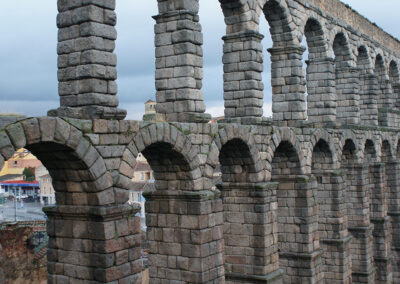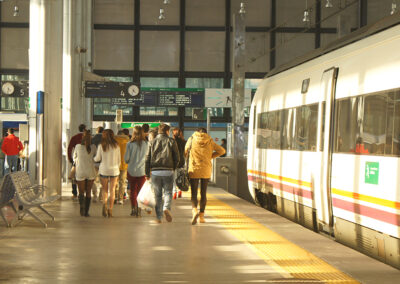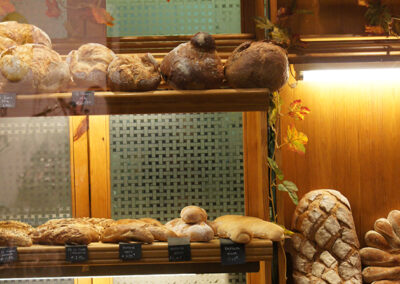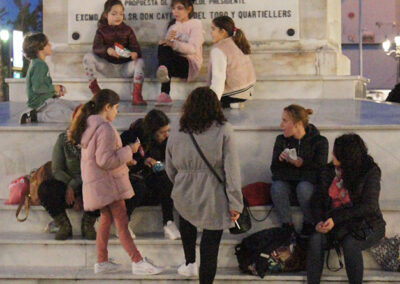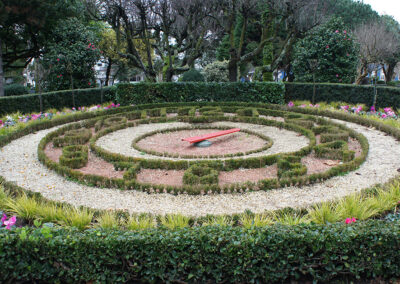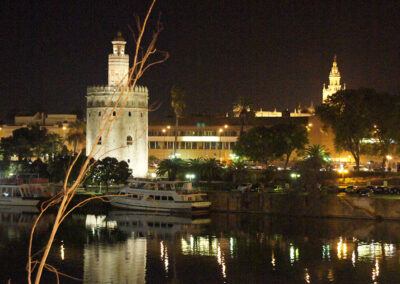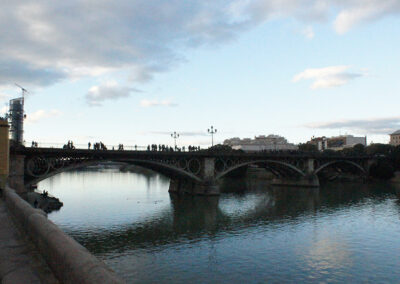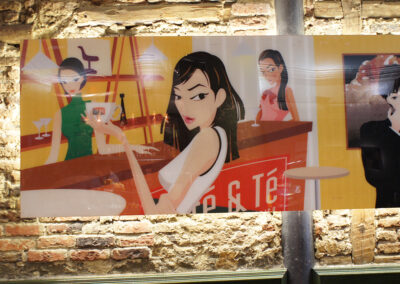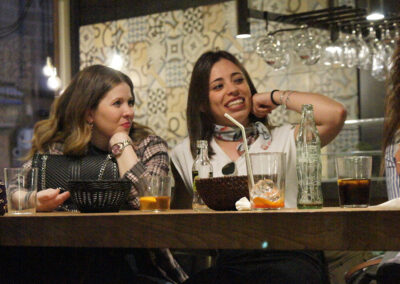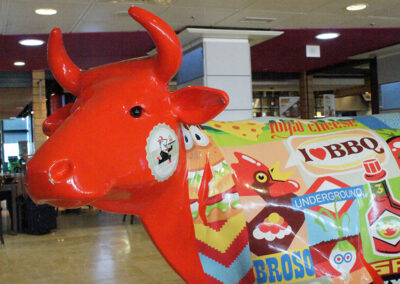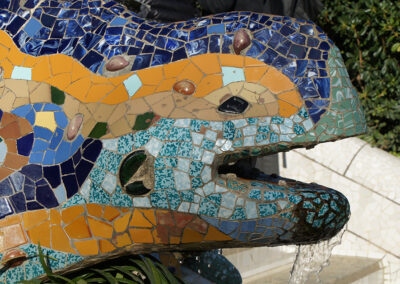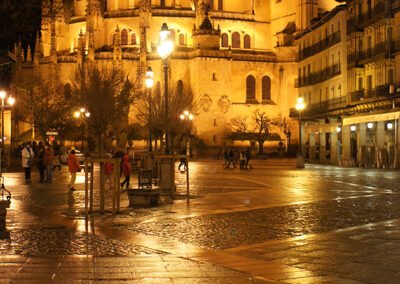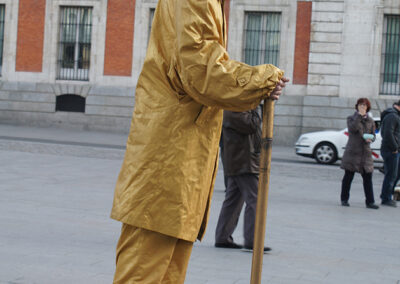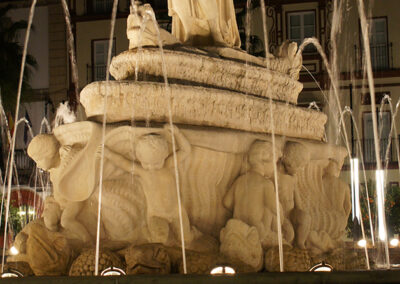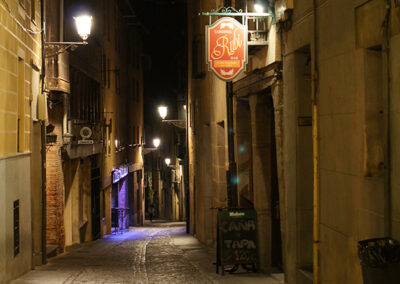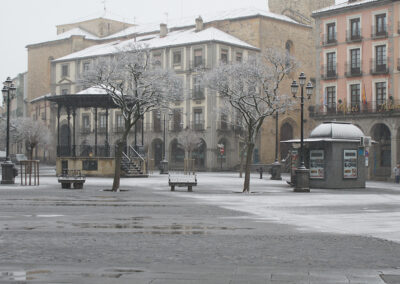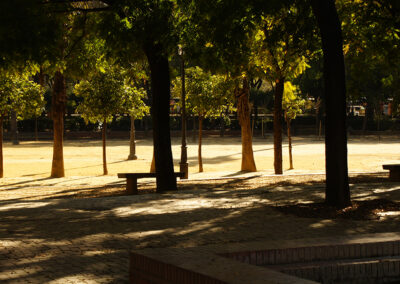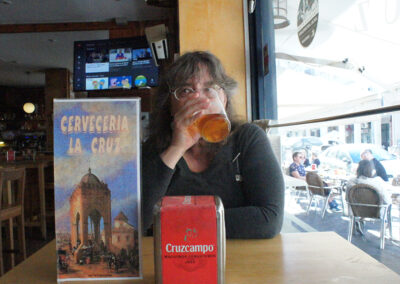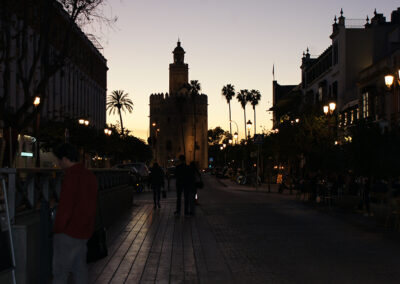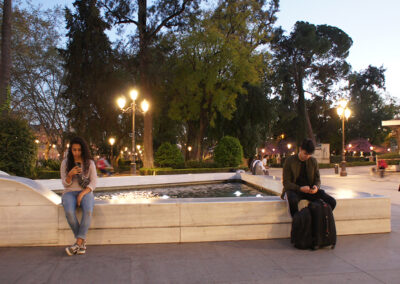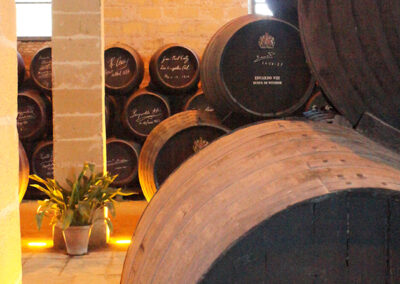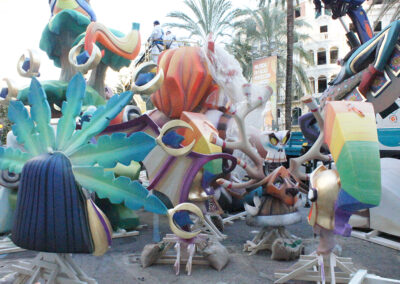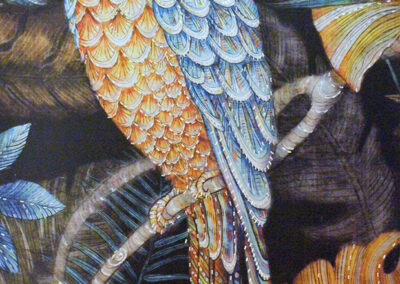Trips
Our Trip to Spain:
In common with many other Canadians, Marie-Helene and I think that January is an excellent time of the year to take a trip away from Canada. And so one afternoon this past January we crossed the pond, headed this time for Spain, and by way of Frankfurt. Although we had booked our tickets with Lufthansa, the eastward flight was operated by Air Canada. The aircraft itself was a 777, and to someone who started crossing the Atlantic on the old DCs 8s, many decades ago, it always seems a bit strange to make the long trek over in a two-engined aircraft. The food was suitably awful (this was Air Canada), and by the time we were over Ireland the cabin was suitably freezing (like I said, Air Canada). We did, however, land in Germany on time, to a dull, gray and very gloomy-looking “Nordic” sky, with the dawn just beginning. The Frankfurt airport is one of the largest in Europe, and after being admitted to the European Union by a blond and corpulent official who could have served as the poster child for European bureaucracy, we were conducted to the Lufthansa lounge to wait for our connecting flight. This is where the real VIP treatment started. Lufthansa knows how to look after its passengers, and we were give all the finest coffee and pastries we could have asked for, as well as a selection of newspapers in German, French and English. After a couple of hours- which of course seemed interminable- we boarded an Airbus for Barcelona, and were shortly on our way.
This was our first time in Spain, and our arrival in Barcelona was truly memorable, especially the airport shopping area (through which all new arrivals are naturally funnelled). The most striking feature, and one that you can’t fail to notice, is the beautiful polished marble floor; it is quite a contrast with the prefab, solid concrete, furnished-with-seconds-from-Staples look of the Pearson terminals. (Spain may be a poor country, but its people sure have a sense of style).
Barcelona turned out to be one of the loveliest cities that we have ever visited. We put up for a few days in the Hotel Continental, right on the pedestrian right of way Las Ramblas, billed as Spain’s most famous street. This is supposedly the hotel that Georges Orwell lived in during the Spanish Civil War, and it seems largely untouched since that bygone era (I think I may have got old George’s bed, judging by the sag in the mattress). Let me just say that we found the hotel quaint, and any little glitches- like the fact that the heat would not come on in our room- were promptly dealt with by the staff who, in common with almost everyone we met in Spain, were very gracious). We visited all the usual sites in town, including Gaudi’s fabled Parc Gϋell, and zipped around town on the tour bus, getting on and off wherever we liked. A high point of our stay in Barcelona was our visit to a very attractive, old-fashioned music store, the Musical Emporium, at 129 Las Ramblas. In this shop, music for sale is stored in ancient leather folios, labelled on the outside by composer. I managed to find one labelled Métodos para instrumentos a cuerdas (“Stringed Instrument Method Books”). I thought to myself “Hmm… this looks promising!”, but in the end it turned out to contain instructional materials for the guitar only……oh well, the guitar is a stringed instrument, and we were in Spain after all….
Our next stop was the old heart of Spain, the central plateau of Castile and Leon. We stayed for five days in Segovia, the capital of a province of the same name, and a town that is supposed to have been founded by Hercules himself (or the son of Noah, depends which source you consult). It seemed a suitable place to celebrate my birthday, seeing as it was in fact my very own special day, and so we went out on the town for a great meal of meat, followed by meat, and more meat. This part of Spain- the old stomping grounds of Cervantes- is a paradise of roasted meats, particularly pork and beef, and as far as I can tell, there is no such thing as a Spanish vegetarian. It was a cold, icy night, just like the original night I was born on, I would imagine (a note to any soft Canadians thinking of a January visit to Spain: this part of Spain is cold in January. Not by our standards, of course, but cold enough to bring on snow and ice. Furthermore, unlike Canadians, the Spaniards do not heat their buildings in any meaningful way. Think England!)
From Segovia we wandered North into Galicia, the old Celtic area of Spain, and a place that I particularly wanted to visit, in view of the impressive amount of Celtic music from the area that is still performed world-wide. Historically and culturally Galicia is as much a part of Portugal as it is of Spain, and the language- which they call gallego- is pretty tough to follow if you only speak standard Spanish. And in a way, the area seems almost British, especially in its diet of fried fish and boiled potatoes! We stayed in A Coruña, a city which I believe was once sacked by the Royal Navy, and which is very much a maritime locale. As everywhere in Spain, the people were accommodating and helpful, and we had a great time.
Last on the itinerary was a few days in the south of Spain, in Andalusia. We made our base in Seville, a fairly large city that has everything that one might need, and which was also allegedly founded by Hercules. The home of flamenco, Seville is also a magnificent setting for photography. There is a university with a great bookstore, a real temptation for me, an inveterate book lover. But I kept myself under control, more or less, and concentrated on the dozens of tiny, “student” restaurants that surround the campus.
From Seville we made a trip south to Jerez de la Frontera, where we had the good fortune to tour a brandy factory. From Jerez we continued south to Cádiz. On the Atlantic coast and not very far west of Gibraltar, Cádiz is supposedly the oldest settlement in all of Europe, going back to the days of the Phoenicians. The city is built on a sort of promontory, and is linked to the mainland by road and rail. A combination of busy port, seagull nesting ground, historic- and amazing- architecture, and of course, a party town extraordinaire, Cádiz would be my personal nomination for “Jewel of Spain”, if such a contest existed.
Alas, all good things come to an end, and after ingesting a huge meal of sardines simmered in fresh garlic sauce, we began the long rail trip back to Barcelona, and on to Canada. The flight back was actually operated by Lufthansa, and we were able to enjoy the finest of airline food- no, I’m not speaking ironically here- served with lots of good coffee and followed by a shot of fine French cognac. Shortly afterwards we landed in Toronto during one of the coldest Januarys on record.
What are we to make of modern-day Spain, especially as seen from the Canadian point of view? Are there any similarities with Canada? Maybe more than meet the eye. First off, like Canada, Spain is a large country, at least by European standards. It is also many nations in one country: Spanish, or Castilian, of course, but also Catalonian, Basque, Galician and Arabic, to name only the most obvious. Like Canada, Spain is also a country of varied climatic and geographical regions, and during our January visit we experienced the foggy and damp northeast, the frigid central plateau and the balmy, sunny south. Again like Canada, there is an active separatist movement- in Catalonia, in Spain’s case- and we had the pleasure of visiting while a referendum was under way. One more parallel with Canada concerns the role of the state. As in Canada, and to an even greater extent, the state plays a prominent role in the economy and meddles freely in individual Spanish lives. But there are differences, of course. Depending on your point of view, Spain has a glorious- or nefarious- colonial history. It has also suffered through a brutal civil war, and long periods of dictatorship. By comparison, Canada has had a rather soft ride. In our own time Spain is dealing with economic stagnation and levels of unemployment far beyond what we are familiar with.
Historically not much is known with any certainty about Spain, or Iberia as it was then known, before the arrival of the Romans and their passion for keeping written records. Roman armies are reputed to have invaded the Iberian peninsula in 218 BC, and by the time of Augustus, who was emperor from 27 BC until AD 14, all of Iberia was under Roman control. As in the rest of the empire, Roman rule was very efficient, and to this day Spanish society is in great measure recognizably Latin. Following the general decay of the Roman Empire, Iberia, now known by its Latin name Hispania, came under the control of the Visigoths. A bit further down the road, during the eighth century, much of central and southern Spain was brought under the rule of the Moorish civilization of North Africa, and was only gradually “re-conquered” (to use the Spanish term) by the Catholic Monarchs to the north; the last Moorish state in Spain was Granada, which fell to the Catholic forces in 1492.
The birth of modern Spain dates from 1469, the year of the union through marriage of the Kingdom of Castile in central Spain, and the Crown of Aragon in northeastern Spain (where much of Catalonia now lies). The capital was first located at Toledo, famous for its steel instruments, and later moved to Valladolid and then to Madrid. The role Spain played in the “New World” is too well known to need any retelling here. Ditto Spain’s loss of empire and return to single-nation status (much like the fate that befell England, though swifter and more brutal).
What is less well known, perhaps, is the tremendous role that Spain has played in the worlds of the arts and learning, from ancient times right through to the 21st century. First off, we might mention Spain’s role as a conduit of learning from the more ancient Asian and African civilizations into the much younger European civilization. We sometimes forget that through Europe’s long, medieval slumber, learning was kept alive in the Arabic world, and that Spain was the entry point of such treasures as Arabic mathematics into Europe. Some inventions from further afield, most likely India, also entered Europe through Spain, by way of the Arabic civilizations in Northern Africa. Among them are the guitar and the game of chess. In its own right, Spain has given the world many giants of literature, including the originator of the modern novel, Miguel de Cervantes. Equally in architecture and painting Spain has supplied a seemingly endless supply of talent, including of course Picasso, who was beyond doubt the leading painter in the modern world.
What impression did Marie-Helene and I carry away from our whirlwind tour of Spain? An impression certainly of a nation, poor in the modern world, but with a romantic past of gigantic proportions. An impression of a country that is still architecturally and psychologically part of the old Roman Empire. On the periphery, perhaps, though very much a part of the whole, ongoing Latin world, centered in Italy. A place where Africa blends into Europe in the northeast and into the Atlantic-Celtic world in the northwest. A place technologically advanced enough to manufacture major components of the Airbus aircraft fleet, and yet where even the smallest town seems to have a potter, basket weaver and jewelry maker. Above all, however, a place that is knitted together by the friendliness and graciousness of a very outgoing and warm-hearted people.
To view the photographs from the Trip to Spain, please click on: www.flickr.com/photos/richardtweney.

